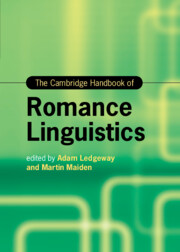Book contents
- The Cambridge Handbook of Romance Linguistics
- Cambridge Handbooks in Language and Linguistics
- The Cambridge Handbook of Romance Linguistics
- Copyright page
- Dedication
- Contents
- Figures
- Tables
- Contributors
- Abbreviations
- 1 Data, Theory, and Explanation: The View from Romance
- Part One What Is a Language?
- Part Two Phonetics and Phonology
- Part Three Morphology
- Part Four Syntax
- Part Five Semantics and Pragmatics
- Part Six Language, Society, and the Individual
- 27 Register, Genre, and Style in the Romance Languages
- 28 Contact and Borrowing
- 29 Diamesic Variation
- 30 Social Factors in Language Change and Variation
- Index
- References
27 - Register, Genre, and Style in the Romance Languages
from Part Six - Language, Society, and the Individual
Published online by Cambridge University Press: 23 June 2022
- The Cambridge Handbook of Romance Linguistics
- Cambridge Handbooks in Language and Linguistics
- The Cambridge Handbook of Romance Linguistics
- Copyright page
- Dedication
- Contents
- Figures
- Tables
- Contributors
- Abbreviations
- 1 Data, Theory, and Explanation: The View from Romance
- Part One What Is a Language?
- Part Two Phonetics and Phonology
- Part Three Morphology
- Part Four Syntax
- Part Five Semantics and Pragmatics
- Part Six Language, Society, and the Individual
- 27 Register, Genre, and Style in the Romance Languages
- 28 Contact and Borrowing
- 29 Diamesic Variation
- 30 Social Factors in Language Change and Variation
- Index
- References
Summary
The information-structural categories of focus and topic are examined with respect to the constructions in which they can feature, including fronting, dislocation, subject inversion, and presentational sentences. The role and effects of illocutionary force distinctions (e.g., declarative, interrogative, exclamative) and different predication types (thetic vs non-thetic predications) are also taken into consideration. Despite the many similarities, (micro)variation in this area proves quite considerable. In relation to Romance comparative data, this chapter shows that this variation can be accounted for by pragmatic-discourse factors and structural licensing principles that are indeed related to information structure.
Keywords
- Type
- Chapter
- Information
- The Cambridge Handbook of Romance Linguistics , pp. 817 - 844Publisher: Cambridge University PressPrint publication year: 2022

